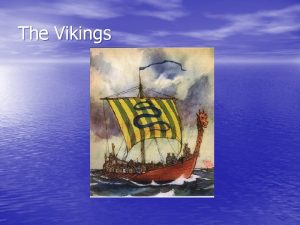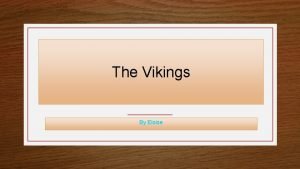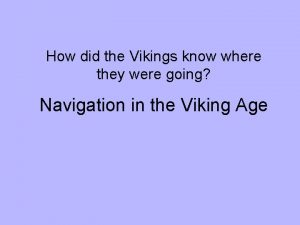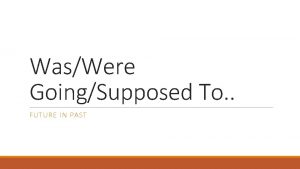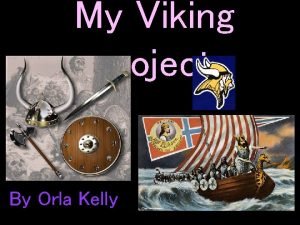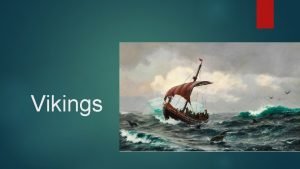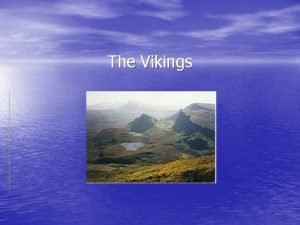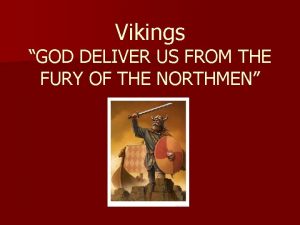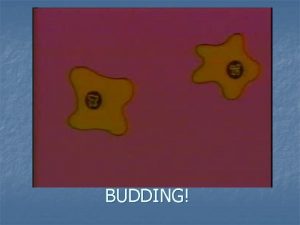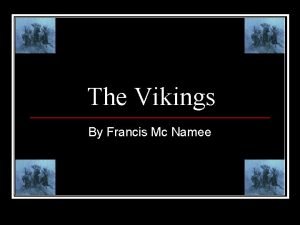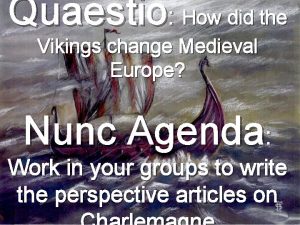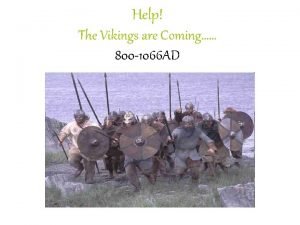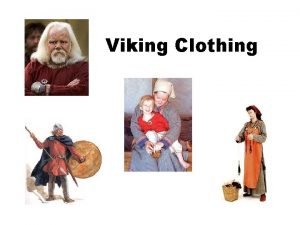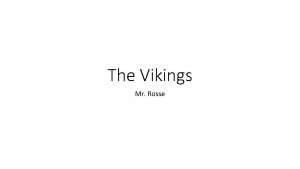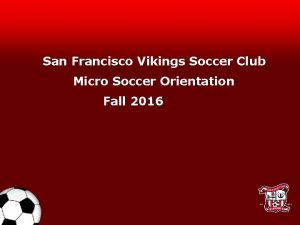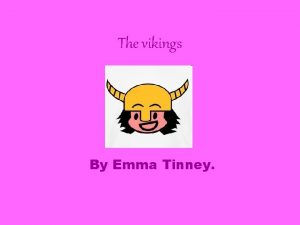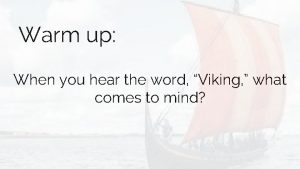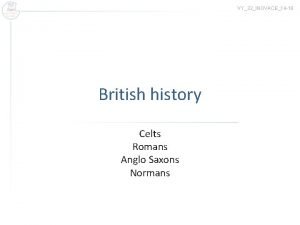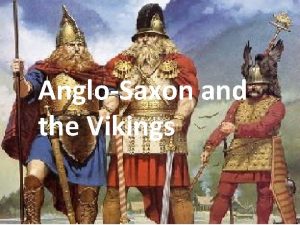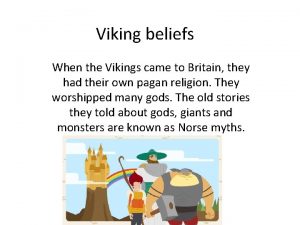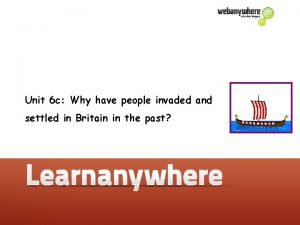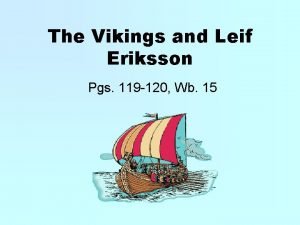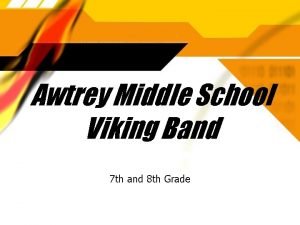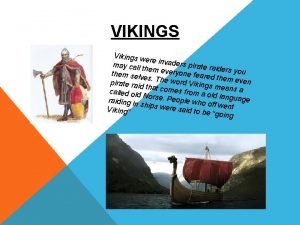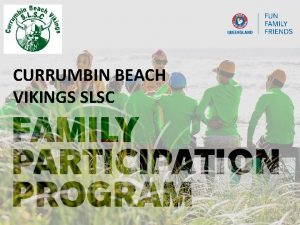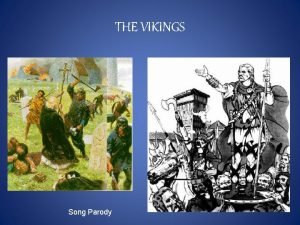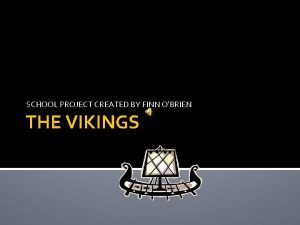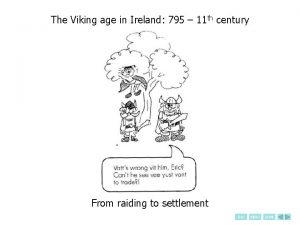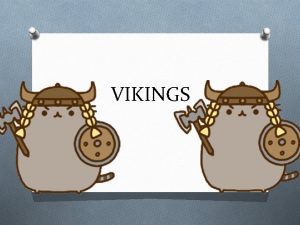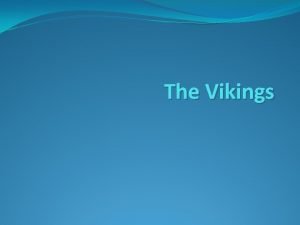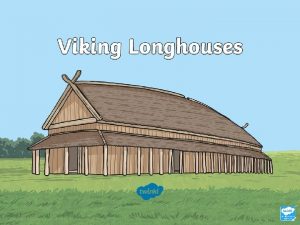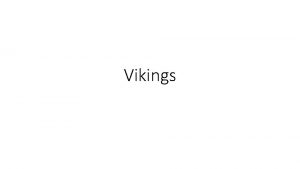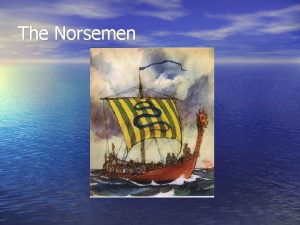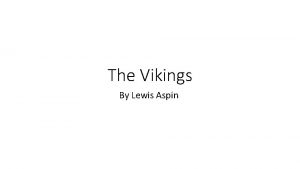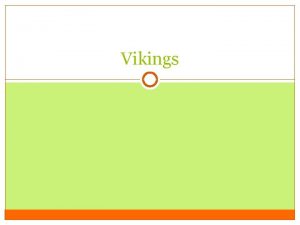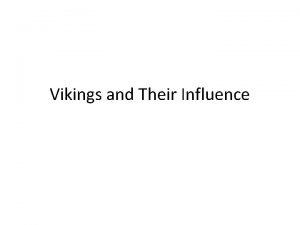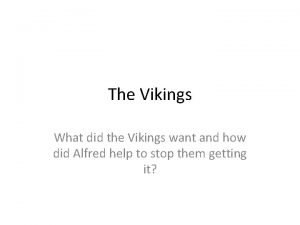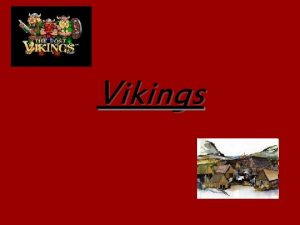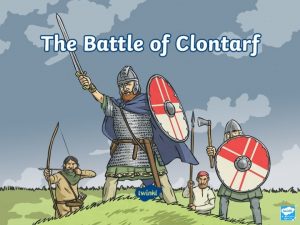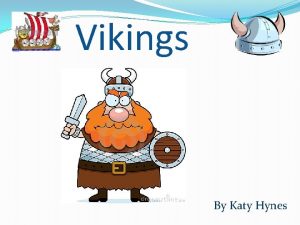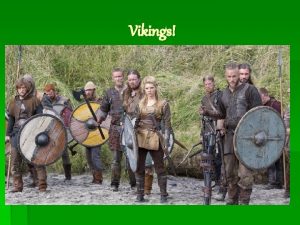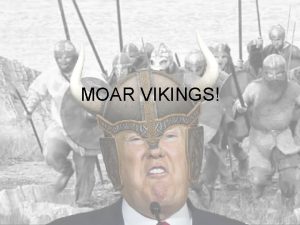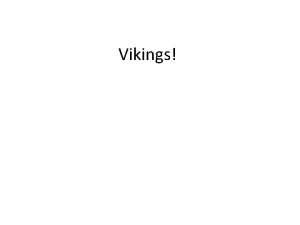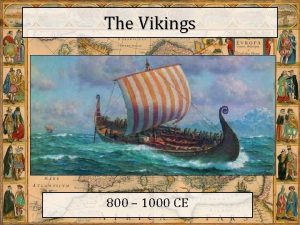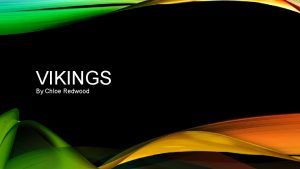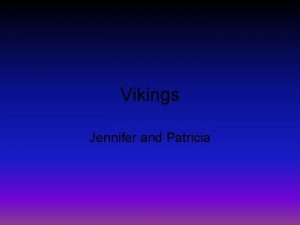The Vikings Who were the Vikings The Vikings







































































- Slides: 71

The Vikings

Who were the Vikings?

The Vikings • The Vikings came from three countries of Scandinavia: Denmark, Norway and Sweden. The name 'Viking' comes from a language called 'Old Norse' and while now used as a noun (naming word) to describe the people of Scandinavia from the ‘Viking Age’, the word ‘Viking’ was originally a verb (doing word) that means 'a pirate raid'. People who went off raiding in ships were said to be 'going Viking'. • The Viking age in European history was about 700 to 1100 CE. During this period many Vikings left Scandinavia and travelled to other countries, such as Britain and Ireland. Some went to fight and steal treasure. Others settled in new lands as farmers, craftsmen or traders.

Meet Snorri Ya, I am Snorri. I am a Viking. Is Snorri historically accurate?

Viking helmets had no horns. They were round and made of leather with metal reinforcing Vikings wore woollen tunics with sleeves Vikings neatly combed their beards and their hair Vikings wore long cloth trousers is historicallyinaccurate because… Snorri is historically because…

Meet Jarl Borg Is Jarl Borg historically accurate?

John Green – Crash Course • The Vikings • https: //www. youtube. com/watch? v=Wc 5 z. UK 2 MKNY

Geography of Scandinavia • Scandinavia’s geography affected where the Vikings could settle and what types of work they could do. • 1. Read and fill in the worksheet on Scandinavian Geography.

Travel • Scandinavia’s rugged landscape and few roads meant that travel by land was slow difficult. • The Vikings travelled widely by both land sea. Their journeys linked them to different areas within Scandinavia, to the rest of Europe, to North America, to Asia and to North Africa. Through travel, trade and exploration, the Vikings expanded their knowledge of other cultures, increased their trade networks and shared access to new ideas.

How did Vikings travel? • Given the difficulties of travel by land, boat travel was important to the Vikings. They were skilled boatbuilders, sailors and navigators. The Vikings designed boats to suit the needs of different types of trips, e. g. fishing boats, and longships.

Viking Longships • The Vikings were master builders and their longships had features that made them well-suited to raid: • Wide hulls gave the longship stability. • Some ships had carved wooden figureheads, e. g. of a dragon. • Were light and narrow. • Generally 18 metres long. • Large sail and al least 24 oars so that sails could use the methods best suited to the conditions.

Viking homelands and settlement

Activity • Complete the worksheet on Viking Longships.

Viking Warriors • When watching the video answer the questions on the worksheet. • https: //www. youtube. com/watch? v=Xd 7 qngt. CTA

The Vikings and Lindisfarne

Learning Intent • The learning intent for this lesson is to: • To understand the events of the Vikings’ raid on Lindisfarne • To be able to outline the consequences of the raid on Lindisfarne

Vocabulary Monastery: Plundered: Raid: A rapid surprise attack on an enemy. A building or buildings occupied by a community of monks living under religious vows. Steal goods from (a place or person) using violence, especially in time of war.

The Raid of Lindisfarne • This was the first major Viking _______ recorded in England. Few had contemplated such a _____ from the sea could happen. • They came from the sea in a whirlwind of violence. In 793 CE, the Christian _____of Lindisfarne off the Northumbrian coast was ransacked by Vikings. They ____ and showed no mercy. • The raiders hacked the monks to death or dragged them into the sea and drowned them. They were after the unguarded treasures of _____. Attack, Monastery, Plundered, Raid, Lindisfarne

The Raid of Lindisfarne • Some believed that the monks brought the raids on themselves – that it was a message from God. • The Viking raids were the first official assault on Christianity. • The attack on Lindisfarne had far reaching effects because it was considered an assault on Christianity. News of this invasion travelled across Europe.

What happened after the Vikings left? • Following the destruction of Lindisfarne, the Vikings cast their attention to other easy targets. Monasteries were their favourites because of the riches contained in them.

Viking Raid of Lindisfarne • https: //www. youtube. com/watch? v=LLPate. Kei. Ww

Review Write one paragraph which describes what happened at Lindisfarne and why it was important.

Viking Quest Activity • http: //www. bbc. co. uk/history/interactive/games/viking_ques t/index_embed. shtml

Let’s review what happened at Lindisfarne…

Raid of Lindisfarne • From the late eight century, the Vikings engaged in violent ‘hit and run’ campaigns of plunder against the villages and towns of Europe. Each spring and summer, they travelled in longships from their homelands towards easy targets from which they could gain wealth. • The raid of Lindisfarne in 793 marked the beginning of a new era in which people lived in fear of the terror these sudden Viking raids unleashed. • In 794 the Vikings returned to attack Jarrow and Wearmouth, two of the other monasteries on England’s north-east coast. Monasteries were their favourites because of the riches contained in them.

Vocabulary • Monk: • Raid: A particular attitude towards or way of regarding something; a point of view. A member of a religious community of men. • Seafaring: A rapid surprise attack. • Perspective: Regularly travelling by sea.

A Monks Perspective • Alcuin (735 -804) is relied on heavily as a source for the late eighth century. • He was hand-picked to serve as an advisor to the emperor Charlemagne and invited to act as head of his palace school having established a reputation as being one of Europe’s primary scholars. • Alcuin was perfectly placed to observe the unfolding of the later eighth century and was a contemporary source for the early stages of a "Viking age. "

Alcuin Fact • A Monk • British • Scholar Assumed knowledge • Placed a great amount of emphasis on religion • Supporter of England • Intelligent, trustworthy source of information

Viking Raid on Lindisfarne written by Alcuin

Alcuin Task • Read answer the worksheet on Alcuin’s letter to Higbald.

Review True or False: Alcuin blamed the Vikings for the attack on Lindisfarne. False - Alcuin thought that the people of Lindisfarne must have angered God in some way and brought the attack upon themselves

What about the Vikings perspective? What reasons could they have had for the attack? • • •

Writing Task: Vikings Perspective Pretend you are a Viking who attacked the Lindisfarne monastery. Write a diary entry about the attack which includes: • Reasons for the raid from a Viking’s perspective

Group Research Activity • In small groups or pairs, read through pages 214 – 217 in the text book and answer the following questions: • 1. When did the Viking raids begin and what were their main features? • 2. How did Viking raid parties change over time? • 3. List 3 features of Viking longships that made them well -suited to ‘hit and run’ raids.

NORSE MYTHOLOGY

Vocabulary • Pagan: A collection of myths, especially one belonging to a particular religious or cultural tradition. • Norse: A long story of heroic achievement, especially a medieval prose narrative in Old Norse or Old Icelandic. • Mythology: Norwegians or Scandinavians in ancient or medieval times. • Saga: A person holding religious beliefs other than those of the main world religions.

Valhalla and the Valkyries • According to legend, the Valkyries were women who used to ride to the battlefields to collect the dead warriors and take them to Odin’s castle, Valhalla. • These heroes used to relive their battles each morning and then, having recovered from their wounds, would spend the night feasting with Odin. • These legends taught people that warriors preferred to die on the battlefield, rather than in their own beds.

Norse Gods • The Vikings believed in a number of different gods and goddesses. They believed the gods lived in Asgard, a place full of beautiful palaces, which they could get to only by crossing a rainbow bridge. • The Gods looked, and in many ways behaved, like humans. At the same time, they were able to do special responsibilities in the human world.

ACTIVITY You are to research a Norse God or mythical creature and fill out the worksheet. • Norse Gods - Baldur, Odin, Thor, Freya, Loki, Heimdall, Hel, Sif, Njord, Tyr, Frigg • Mythical Creatures – Jormungandr, Fenrir (Fenris Wolf),

Ragnarok • In Norse mythology, Ragnarok is a series of future events, including a great battle, foretold to ultimately result in the death of a number of major figures (including the gods Odin, Thor, Týr, Freyr, Heimdallr, and Loki), the occurrence of various natural disasters, and the submersion of the world in water.

Ragnarok

Runes • The Vikings believed that Odin hung upside down on the tree of knowledge for nine days. When he saw the runes, he used his sword to carve them into the tree. In return for gaining the wisdom and magic powers from the runes, Odin gave up his left eye. • Because of this sacrifice, the Vikings considered the runes to be sacred.

Runes weren't used to write stories. They were used for everyday writing such as _______ household items and personal _______. They were also used by _____ to keep records of items bought and sold. Merchants, Labelling, Belongings Wood tag identifying property, reading "Thorgrim's pile”

RUNES Viking warriors decorated their swords and spears with runic symbols They are different to the runic alphabet. They use curves. They believed the runes were magical, and made the weapon stronger in battle. Vikings believed that warriors who knew how to read and write runes could blunt enemies' weapons, break chains, cure illnesses, guard against witches and be protected in battle and on threatening seas.

Younger Futhark • Younger Futhark or "Normal Runes" were the main alphabet in Norway, Sweden and Denmark throughout the Viking Age. • Three slightly different versions of the alphabet developed in Denmark, Norway and Sweden - the first row of runes are the Danish ones, the second row are the Norwegian ones, and the third row are the Swedish ones

The Viking Sagas • https: //www. youtube. com/watch? v=8 KSx. M 0 g 1 EY 8

Viking Society

Vocabulary • Communities: The aggregate of people living together in a more or less ordered community. • Govern: A group of people living in the same place or having a particular characteristic in common. • Society: Conduct the policy, actions, and affairs of (a state, organisation, or people) with authority. • Ranks: • Titles: A name that describes someone’s position or job. A position in a hierarchy.

How did the Vikings govern themselves? Although the Vikings horrified the English, worshipped Pagan Gods, and raided villages, they have a fascinating, and complex social hierarchy.

Titles and Ranks

Viking Society: Titles and Ranks • There were three main groups in Viking society: • 1. The nobility – The Jarls and Kings had three main functions: To serve as judge during the popular assemblies, to serve as a priest during the sacrifices, and to serve as a military leader during wars. Jarls The title of Jarl was the highest rank below the king. The Jarl was the only one, beside the king himself, who was entitled to have a hird (large armed). • 2. Karls (Freeman) – Farmers, trade and craftspeople, warriors (and their families). • 3. Thrall (slaves) – People who had been abducted in raids or brought in other countries by the Vikings, or who had sold themselves into slavery to pay off debts.

Kings and Things A local assembly called thing, met each autumn and spring to make the key decisions that the Jarls had to follow. Meetings of the thing took a few days and people usually held a festival. Some things had more power than others and could elect a king to lead a large area. At the beginning of each thing a law-speaker used to recite by heart the laws of the community. No one wrote these down. People would discuss local problems and issues, before deciding what should be done in accordance with the law. As time passed Jarls, through wealth and their power as conquers became more influential than things.

Honour and Revenge • Viking society expected its members to live by a code of honour that provided unwritten guidelines for their roles in every aspect of daily life and also on special occasions. This code of honour meant: • Supporting one’s friends • Being loyal and supportive to a group to which they might belong and its leader • Taking action against one’s enemies • Not bringing disgrace on one’s community

Viking Daily Life • Vikings were self-sufficient, providing for oneself without needing outside help. This was very important in Viking society. • People had to produce their own food and also tools, equipment and transport to obtain it and move it to where it was needed. This made farming, and specialist skills in metalwork, woodwork and boat building, some of the most important forms of work in the Viking community.

Viking Daily Life • Most Vikings were peasants who owned or rented the farmland they worked. Some lived along fjords in houses grouped to form small communities. Others lived a more isolated existence on farms scattered through valleys further inland. • The people spent their time farming, fishing and trapping animals, to obtain the food they needed to eat. • They also kept cattle, goats, pigs, poultry and sheep for food and also to obtain supplies of butter, cheese and milk.

Writing Task Many people think that the Vikings were violent, unorganised communities. After reading what you have read do you agree? Your response should be in paragraph form. Be sure to provide evidence from the source to support your decision.

Longhouses • Viking farmers and their extended families lived in one-room longhouses. Viking homes usually all followed the same form of design and construction. They were made from timber, stone, earth and turf.

Activity • You are to complete the online quiz on Viking homes http: //www. bbc. co. uk/schools/primaryhistory/vikings _at_home/teachers_resources. shtml# • You are to complete the Longhouse activity sheet.

What happened to the Vikings?

Jorvik’s last king • Throughout the Viking Age, there were many battles between the Vikings and the English. In the 9 th century, the English king Alfred the Great stopped the Vikings taking over all of England. • In the 10 th century the English reconquered much of the land held by Vikings. In 954, they drove out Eric Bloodaxe, the last Viking of Jorvik. After Eric was killed in battle, the Vikings in England agreed to be ruled by England's king.

King Cnut In Viking times, a king had to be strong to fight and keep his land. In the early AD 1000 s, England had a weak king. His name was Ethelred 'the Unready'. Ethelred gave Viking raiders gold to stop their attacks. The Vikings took the gold, but still attacked anyway. So in 1002, Ethelred's soldiers killed Viking families in the Danelaw. This made King Sweyn of Denmark so angry he invaded England. Ethelred had to run away. In 1016 Sweyn's son Cnut became king of England. Cnut (also known as Canute) was a Christian and a strong ruler. For the next few years England was part of his Viking empire, along with Denmark and Norway

The Norman Conquest • In 1066 England was conquered by William, Duke of Normandy. The Normans were the descendants of Vikings who had settled in France. They took over all of England, including the Danelaw. In 1069 the Normans burned Jorvik. This was the end of the Viking Age in England. • In Scotland, Viking earls went on ruling some islands for hundreds of years. They were driven from the mainland of Scotland by 1100, but remained 'lords of the isles' (the Western Isles) until the 1200 s. The islands of Orkney and Shetland were more Norwegian than Scottish. They did not officially become part of Scotland until 1469.

Task • See if you can find and read the most famous story about King Cnut. What does the story tell us about him? Was he a good king? He had two sons. What were they like as rulers? • Write a diary of the year 1066. What part did the Norwegian king Harold Hardrada and his Viking army play in the story?

Archaeology

Vocabulary • Archaeology: The quality of being worthy of attention; importance. • Significance: The study of human history and prehistory through the excavation of sites and the analysis of artefacts and other physical remains. • Artefact: The reason for which something is done or created or for which something exists • Purpose: An object made by a human being, typically one of cultural or historical interest

Learning Intent: To understand how archaeological evidence (primary sources) contribute to our understanding of past civilizations To be able to: -evaluate primary sources for nature, purpose and significance. Vocabulary: significance, archaeology

Archaeology • Archaeology – the study of ancient artefacts to draw conclusions about how societies lived in the past • http: //www. youtube. com/watch? v=es. Bbsvnezfo

What the Vikings left behind • Archaeologists find the remains of Viking houses, burial sites, treasure hoards, carvings on stones, and writing carved in runes. Vikings left their mark on Britain in other ways too, such as language, Lots of familiar English words originally came from the Vikings' Norse language. Examples are 'husband', 'egg', 'law' and 'knife'. • The Vikings also left behind many stories about real people, called 'sagas'. Scotland has its own saga from the Viking Age, called 'Orkneyinga Saga' or 'The History of the Earls of Orkney'.

Source: Rune stone Nature: • Pick or chisel • Stone Writing / drawing on stone Purpose: • To communicate Significance • They have a language • They have paint • They have tools • Religious Conclusion The Vikings had a functional language and they had the ability to create art.

Your Task Draw conclusions about what the artefacts tell us about Vikings and their way of life on your worksheet. Consider: • technology (crafts and use of metal) • transportation (use of ships) • warfare • culture (writing, art, religion, religious beliefs).

Do the artefacts support or disprove the following hypothesis? The Vikings were a civilised people.
 Where did the vikings originate from
Where did the vikings originate from Viking from
Viking from Who were the vikings and where did they come from
Who were the vikings and where did they come from How did the vikings know where they were going
How did the vikings know where they were going Future in the past was were going to examples
Future in the past was were going to examples Where did the vikings originate from
Where did the vikings originate from Vikings sack paris
Vikings sack paris Where did vikings originate
Where did vikings originate Scandinavian explorers
Scandinavian explorers From the fury of the northmen deliver us
From the fury of the northmen deliver us Nn budding
Nn budding Vikings mc norway
Vikings mc norway How did the vikings change medieval europe
How did the vikings change medieval europe Danelaw area
Danelaw area Mens wool cloak
Mens wool cloak Danelaw map
Danelaw map Viking ship anatomy
Viking ship anatomy Micro pro soccer
Micro pro soccer Pirate bay competitors
Pirate bay competitors Viking children clothes
Viking children clothes When did the vikings stop raiding
When did the vikings stop raiding Celts romans anglo saxons vikings normans
Celts romans anglo saxons vikings normans Anglo saxon days of the week
Anglo saxon days of the week Viking beliefs
Viking beliefs Where did the vikings go
Where did the vikings go Leif eriksson
Leif eriksson Vikings and turks
Vikings and turks Viking doc band
Viking doc band Pirate bay vikings
Pirate bay vikings Vikings region
Vikings region Vikings slsc
Vikings slsc Vikings parody
Vikings parody Finn vikings
Finn vikings Viking era timeline
Viking era timeline Thế nào là mạng điện lắp đặt kiểu nổi
Thế nào là mạng điện lắp đặt kiểu nổi Hình ảnh bộ gõ cơ thể búng tay
Hình ảnh bộ gõ cơ thể búng tay Khi nào hổ con có thể sống độc lập
Khi nào hổ con có thể sống độc lập Các loại đột biến cấu trúc nhiễm sắc thể
Các loại đột biến cấu trúc nhiễm sắc thể Thế nào là sự mỏi cơ
Thế nào là sự mỏi cơ Phản ứng thế ankan
Phản ứng thế ankan Voi kéo gỗ như thế nào
Voi kéo gỗ như thế nào Thiếu nhi thế giới liên hoan
Thiếu nhi thế giới liên hoan điện thế nghỉ
điện thế nghỉ Fecboak
Fecboak Một số thể thơ truyền thống
Một số thể thơ truyền thống Trời xanh đây là của chúng ta thể thơ
Trời xanh đây là của chúng ta thể thơ Thế nào là hệ số cao nhất
Thế nào là hệ số cao nhất Lp html
Lp html Hệ hô hấp
Hệ hô hấp Thế nào là số nguyên tố
Thế nào là số nguyên tố đặc điểm cơ thể của người tối cổ
đặc điểm cơ thể của người tối cổ Các châu lục và đại dương trên thế giới
Các châu lục và đại dương trên thế giới Chụp phim tư thế worms-breton
Chụp phim tư thế worms-breton ưu thế lai là gì
ưu thế lai là gì Tư thế ngồi viết
Tư thế ngồi viết Cái miệng bé xinh thế chỉ nói điều hay thôi
Cái miệng bé xinh thế chỉ nói điều hay thôi Mật thư anh em như thể tay chân
Mật thư anh em như thể tay chân Các châu lục và đại dương trên thế giới
Các châu lục và đại dương trên thế giới Từ ngữ thể hiện lòng nhân hậu
Từ ngữ thể hiện lòng nhân hậu Bổ thể
Bổ thể Tư thế ngồi viết
Tư thế ngồi viết Thẻ vin
Thẻ vin Ví dụ về giọng cùng tên
Ví dụ về giọng cùng tên Thơ thất ngôn tứ tuyệt đường luật
Thơ thất ngôn tứ tuyệt đường luật Chúa yêu trần thế alleluia
Chúa yêu trần thế alleluia Hươu thường đẻ mỗi lứa mấy con
Hươu thường đẻ mỗi lứa mấy con Diễn thế sinh thái là
Diễn thế sinh thái là Vẽ hình chiếu vuông góc của vật thể sau
Vẽ hình chiếu vuông góc của vật thể sau 101012 bằng
101012 bằng Công thức tính thế năng
Công thức tính thế năng Tỉ lệ cơ thể trẻ em
Tỉ lệ cơ thể trẻ em Lời thề hippocrates
Lời thề hippocrates

